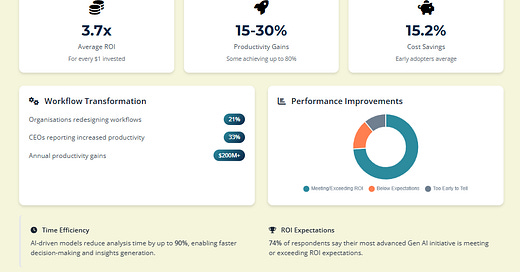Manus Slides: My Experience Building a Strategic PPT Presentation (the best one so far)
PowerPoint slides are the holy grail for consultants—crisp visuals, structured logic, and strategic clarity all in one deck. They’re not just a format, they’re a language every client understands
When I first heard Manus had launched a tool for creating presentations—Manus Slides—I was intrigued. I’ve long struggled with balancing quality, design, and speed when preparing visual content, mainly PowerPoint presentations. So when Manus introduced an AI-driven presentation builder that promised stunning designs and real-time generation based on natural language prompts, I knew I had to try it.
I wasn’t disappointed—but the journey had its nuances. Here's a detailed, honest account of my experience creating a “Generative AI: 2025 Trends and Beyond” PowerPoint deck using Manus Slides.
The Setup: What I Asked
My prompt to Manus was intentionally minimal and vague:
“Build a PPT presentation on Generative AI, mainly focusing on 2025 trends. Be very accurate, source-based, and create incredible designs and layouts, as if you were working for a strategic consultancy company.”
I also added: “Make sure the output is in UK English.”
That’s it. No formatting guidelines, no slide count limit, no content breakdown. In many ways, this was the worst-case user prompt—poorly structured and wide open. And that’s where Manus surprised me.
🔧 Step-by-Step: What Manus Did
1. Prompt Interpretation and Project Setup
Manus instantly began outlining a plan:
Creating a task list
Setting up a project directory
Researching the topic across trusted sources (Microsoft, Morgan Stanley, etc.)
Structuring slide content and layouts
Creating a consistent design concept
2. Research Phase
Manus conducted a genuinely deep dive into the topic:
Trends from Microsoft and Morgan Stanley
Industry stats (e.g., $62.72B market by 2025)
Adoption patterns (75%+ of companies)
ROI metrics, emerging technologies, and ethical concerns
It logged every step, showing its thought process as it curated content.
3. Slide Structure Creation
It generated a 16-slide outline with strategic depth:
Introduction & Market Context
Trends (AI reasoning, agents, multimodal systems)
Integration, ROI, and Responsible AI
Industry-specific applications
Strategic recommendations and future outlook
This structure would easily rival that of a top-tier consulting firm’s deck.
4. Slide-by-Slide Development
Each slide was designed and populated with content:
Accurate data points
Graphs and icons
Strategic tone
Professional typography and colour palette (deep navy, teal, cream)
The design felt polished—modern but not flashy. It was ideally suited for a strategic Substack article or client pitch.
Check it here in PDF (Substack does not support PPT):
✅ The Ups
Here’s what impressed me most:
1. Best AI Slide Builder I’ve Seen (So Far)
I’ve tried Gamma, Tome, Canva Magic, and ChatGPT-based methods (and of course, Plerplexity Labs). None of them achieved this level of depth and accuracy with such minimal input.
2. Launched This Week and Already Polished
For a launch-day product, Manus Slides felt surprisingly stable and capable. There were no lags, crashes, or formatting errors during the generation process.
3. Design Quality
I’m particular about layout aesthetics. The slide hierarchy, colour balance, font choices (Montserrat/Open Sans), and visual pacing were exceptional.
4. Content Accuracy
Despite my vague prompt, Manus relied on sourced data and cross-checked trends. It showed its research log, citing credible industry reports.
⚠️ The Downs
That said, it wasn’t perfect, though I partly blame my poor prompt.
1. No Source Citations in Final Slides
Despite sourcing good data, Manus didn’t attribute it explicitly on the slides. A brief footer reference or bibliography slide would have added tremendous value.
2. Inconsistent Page Size
Some slides were rendered in slightly different formats—minor enough not to break the experience, but noticeable when viewed side by side (as seen in the PDF cuts).
3. Visual Layering Issues
A couple of objects overlapped—e.g., icons covering chart labels. These were easy to fix in PowerPoint, but it suggests the design engine still needs refinement.
🧠 Tips for Using Manus Slides Effectively
Here’s how I’d recommend using Manus for Substack creators or professionals:
🔹 Be Specific in Your Prompt
Include the desired tone, audience, slide count, visual examples (e.g., “like McKinsey decks”), and required data sources.
🔹 Ask for References
Include “please cite all sources” or “add a bibliography slide” to avoid the missing reference issue.
🔹 Review the Visual Output
Before publishing or presenting, check for overlapping elements or font scaling issues, mainly when exporting to PowerPoint or Google Slides.
🔹 Use it as a Foundation
Manus doesn’t replace human creativity, but it gives you a 90% done deck—accurate, well-designed, and editable. That’s a huge time-saver.
Final Thoughts
Manus Slides is the most impressive AI presentation builder I’ve used. From one of the vaguest prompts I’ve ever written, it produced a research-driven, design-rich deck worthy of being published directly on Substack (PDF Version).
While it’s not flawless—citation gaps and some visual quirks exist—the core experience is genuinely game-changing. For professionals, content creators, and consultants, Manus Slides offers a massive productivity unlock with surprisingly strategic output.
Verdict: ⭐⭐⭐⭐½
"Launch-day brilliance with a few fixable gaps. If you present ideas often, Manus Slides deserves a place in your toolkit."
If you're curious, the full 16-slide deck on Generative AI Trends for 2025 is now live. And yes, built with just one line of AI-powered magic.








